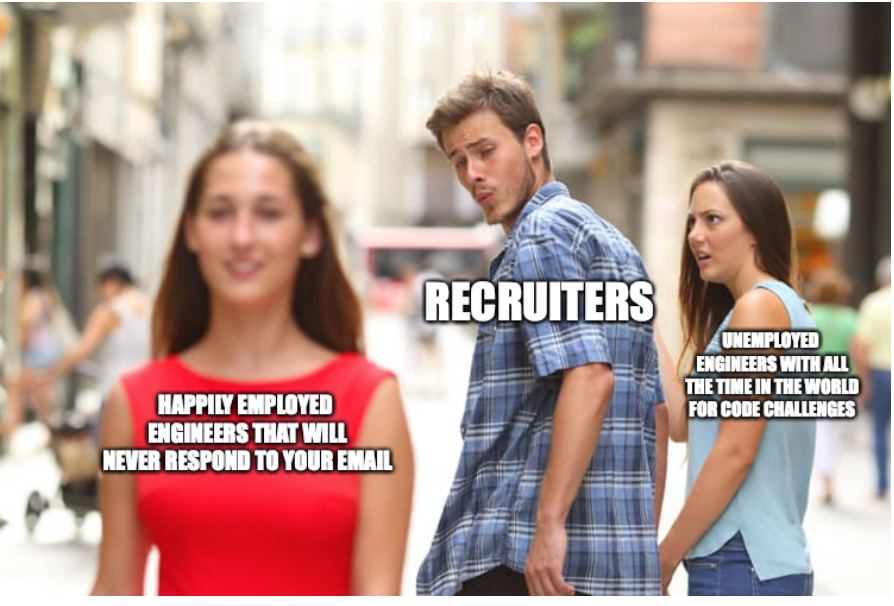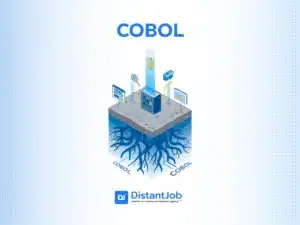Recruiting the best software engineers requires a strategy that goes beyond common hiring. Every step must be correctly tailored to attract and assess top-tier talent. One of those steps is choosing the right test to assess Dev skills. Two tests stand as proven milestones: Live Coding and Take-Home Challenge.
Research from Robert Hire revealed that hiring a bad hire can be costly: around 15%-21% of the salary, depending on seniority. And at uncertain times like ours, the loss can be ever bigger than usual.
The reason why candidates are being tested is that there are many: some skills can be faked, some solutions can be plagiarized, and even our abilities can get rusty over time. Many developers are complaining about coding skills diminishing due to ChatGPT overuse. We must assess that their abilities are top-notch.
What is a Live Coding Interview?
A live coding interview is a real-time coding session where the candidate writes code on the spot. They start coding on a whiteboard or a shared editor and explain their thought process. It can be done via video using collaborative coding tools or screenshare tools. We know that around 72% of companies conduct live coding remotely using platforms with that function, according to HackerRank (an online platform for conducting live coding interviews).
Don’t forget to ask questions during these interviews, as long as they’re relevant. Otherwise, you may be dealing with a guy using a cheat application while Live Coding.
How a Typical Live‑Coding Session Works
You can choose to conduct the live coding interview through a shared IDE or a browser-based service like CoderPad or CodeSignal. These interviews usually take between 45 minutes and an hour and a half. The interviewer usually explains the project’s purpose, then gives time at the end for questions and, sometimes, a quick retrospective on the design’s pros and cons. Our suggestion is to:
- Start by giving a 10‑second brief explanation of the goal, constraints, and allowed libraries. This will reduce candidate anxiety .
- Encourage think‑aloud narration so you can probe decision‑making rather than just keystrokes .
- Reserve the last 5 minutes for the candidate to ask questions or suggest next steps; this reveals architecture thinking beyond the cloc
Below are common types of projects that can be used for such tests:
| Live‑Coding Task | Interview Format | Candidate’s Mission | Skills You Measure |
|---|---|---|---|
| Debugging Challenge | Provide a buggy snippet tied to your domain—logic error, off‑by‑one, race condition | Locate and fix the bug, explain root cause, and (optionally) add a regression test | Problem solving, systematic debugging, test‑first mindset |
| Small‑Feature Implementation | Hand over a pared‑down repo or scaffold; ask for a new feature (e.g., add a filter to a list) | Code the feature, integrate with existing modules, commit tests | Reading legacy code, incremental delivery, git hygiene |
| API‑Integration Task | Share docs or keys for a simple REST endpoint (weather, currency) | Fetch data, handle async errors, display or process results | HTTP fundamentals, async/await or promises, JSON parsing |
| Refactoring Exercise | Present working but messy code (duplication, long methods) | Improve structure without breaking behavior, explain principles | DRY, SOLID, readability, performance tuning |
| TDD Loop | Give a small requirement and require red‑green‑refactor cycles | Write failing test, minimal code to pass, refactor, repeat | Unit‑test fluency, incremental design, discipline under time |
| Database Query / ORM Task | Supply a schema; ask for SQL or ORM code to answer a business question | Write SELECT with joins/aggregations or equivalent ORM call | Data modeling, query optimisation, transaction awareness |
| UI Component Build | Ask front‑end candidates to craft a modal, dropdown, chart in React/Vue/Angular | Implement, style, manage state, ensure accessibility | Framework APIs, CSS skills, event handling |
| DevOps Configuration | Provide a stub repo; request a Dockerfile, Kubernetes YAML, or CI step | Script build or deployment; explain security/cost choices | Container fundamentals, IaC, automation scripting |
Pros & Cons of Live Coding Interviews
Live Coding has many benefits, like checking your candidates’ coding in real time, while letting them explain their methods. However, it can be very distressing to the programmer. You might lose a pro because he was in a bad mood. Know the pros and cons of live coding to manage them effectively in the recruitment process.
Advantages of Live Coding assignments
One of the benefits of the coding format interview is that you get to assess problem-solving in real time. It shows how the candidate breaks down problems, adapts to challenges, and iterates on solutions in real time. This reveals the candidate’s thinking process and creativity under stress and provides insight into their performance.
You can also evaluate soft skills. As candidates code, they must articulate their approach and can be asked to explain or adjust. It reveals their communication skills and how they incorporate feedback.
Coding in real time leaves no opening to hide behind previous feats. You may assess their current abilities.
Cons of Live Coding
Live coding is stressful. Studies show that candidates experience severe anxiety during interviews. You may tell yourself that you are testing them under pressure, but do you wish to assess their skills or their anxiety? It can lead you to a false negative. So that’s a major disadvantage when you use the live coding interview.
Another con can be the time constraints. If you give them only 30 minutes, they can’t solve big problems. Do you want a coder who is a quick fixer or a programmer who can explore complex scenarios with a deep exploration? Live coding will favor the fastest. Candidates who are better with thoughtful and methodical problem-solving may lose the race against the clock.
Communication style influences the recruiter’s perception. A study found that a candidate’s accent, confidence, or conversation style can cause bias. To keep assessments fair, the recruiter must be well-trained. Here is a guide for hiring from Stanford, which includes some pro tips to avoid bias.
What Is a Take‑Home Coding Challenge?
A Take-home coding challenge is an offline coding project that candidates complete on their own (usually given a few days to a week). It helps recruiters narrow down applicants to selected qualified candidates. These challenges can range from building a small app or feature, fixing bugs in a codebase, or solving algorithmic problems. It has far more depth than live coding. According to the 2024 CoderPad’s State of Tech Hiring, Take-Home Challenges scored 3.75 out of 5, the top choice among hiring tests.
Standard Format and Evaluation Workflow
As a hiring manager, you can get a pretty good insight from take-home coding challenges when every candidate receives the same brief, time box, and scoring rubric. When you, as a recruiter, review grade output against clearly weighted criteria instead of gut feel.
We see take-home tests as stress tests and a one-time interview. They are arguably the most essential tool in our toolkit. When presented with this challenge, half of the developers I had already pre-qualified dropped out.
Here’s our recruiter’s checklist for assessment:
- ☐ Send a one‑page brief + repo link
- ☐ Include time expectation (max six hours) and deadline (72 hours)
- ☐ Attach rubric PDF (with weights)
- ☐ Trigger CI for tests, lint, plagiarism
- ☐ Schedule a 30-minute code walk‑through
- ☐ Log-averaged rubric score in ATS
- ☐ Email feedback/stipend within 48 h
Many test formats previously mentioned can be adapted for take-home coding tests, although their emphasis and execution will differ. You must raise the stakes!
Here’s a breakdown of how to use them as take-home assignments:
Example of Take-home Coding Challenges
Instead of a small feature, ask the candidate to build a small, self-contained application or add a more significant feature set to a provided skeleton project.
Example: “Build a simple To-Do list application with data persistence,” “Add user authentication and profile pages to this basic web app,” “Implement the core logic for a recommendation engine based on this dataset.”
Similar to the live version but potentially more complex. Candidates might need to integrate with multiple endpoints, handle more complex data transformations, or build a more complete mini-application around the API.
Example: “Build a simple weather dashboard fetching data from OpenWeatherMap API,” “Create an application that searches and displays GitHub repositories using their API.”
Provide a larger codebase to candidates or a more complex system with multiple, potentially subtle bugs.
Example: “Here is a codebase for a simple e-commerce checkout flow; it has several bugs related to calculation and state management. Fix them and document your changes.”
Provide a more substantial piece of legacy or poorly structured code and ask for significant improvements in structure, readability, testability, or performance.
Example: “Refactor this procedural script into an object-oriented design,” “Improve the performance of this data processing module,” “Increase the test coverage and improve the modularity of this codebase.”
Often involves building a small single-page application (SPA) or a complex, interactive component based on mockups or detailed requirements.
Example: “Build a searchable, sortable data table component,” “Create a simple blog frontend that consumes a mock API,” “Replicate this interactive UI mockup.”
Might involve designing a simple schema, writing complex queries, or building a small application that performs CRUD operations against a database (often providing a Docker setup or using an in-memory DB).
Example: “Design a schema for a simple library system and write queries for common operations,” “Build a small API that interacts with the provided database schema.”
Ask the candidate to implement a specific module or feature strictly using TDD. The commit history can be reviewed to see the process.
Example: “Implement a library for parsing a specific file format using TDD.”
Ask for more complete configuration setups.
Example: “Write a Dockerfile and docker-compose setup to containerize this application,” “Create a basic CI/CD pipeline configuration (e.g., GitHub Actions, GitLab CI) for this project.”
Pros & Cons of Take‑Home Coding Challenges
Take-home challenges can be very exciting, since they challenge a passionate dev. It allows you to explore your candidates’ skills at their peak. However, such tests might be seen as unnecessary homework. Passive candidates might hate to commit to take-home coding while they already have a job. Other candidates might not have the needed gear at home.
Advantages of Take-Home assignments:
One of the benefits of Take-home coding challenges is the real-world simulation. Candidates can use their tools and resources without anyone peeking over their shoulders, much like they would on the job. It allows them to research, use documentation, and work at their normal pace at full potential.
This type of assessment can reveal a developer’s true skills without the stress of an audience or a ticking doomsday clock.
Take-home challenges let candidates tackle bigger problems than in live coding. They can iterate, test, and refine their solution, showcasing their abilities to handle complexity. Recruiters can inspect architecture, readability, testing, documentation, best practices, etc..
Cons
One of the significant disadvantages is the time commitment from candidates: A thorough take-home project might require several hours per day of a candidate’s time. Passive candidates may not have either the time or the interest. You may lose a unicorn because of time constraints (e.g., a clearly scoped challenge that takes no more than 4-8 hours). Be reasonable.
Coding may vary wildly, especially if the project is open-ended. It may be hard to compare very different solutions from candidates. You need clear criteria. Otherwise, recruiters will judge style or architecture based on their own tastes. Make sure you have clear standards on what this challenge needs to evaluate, and communicate them to the candidate.
Side‑by‑Side Comparison Table: Live Coding vs Take‑Home Tests
| Live‑Coding Interview | Take‑Home Coding Challenge | |
|---|---|---|
| Assessment focus | Real‑time problem‑solving, communication and thinking‑out‑loud under time pressure | Code quality, architecture and testing on a larger, more realistic task |
| Candidate experience | Can feel stressful and performance‑anxious, especially for introverts | Flexible scheduling but can be time‑consuming (often several evenings) |
| Time investment | ~60–90 min for both sides; immediate feedback ( | 2–10 hrs for the candidate; review time for engineers |
| Use of real tools | Limited to the shared IDE / whiteboard environment | Candidate can use their own IDE, version control and test suite |
| Cheating / plagiarism risk | Low—session is proctored and interactive | Higher—solutions can be copied or crowd‑sourced unless guarded by plagiarism tools |
| Signal on collaboration & culture fit | High—interviewer sees how candidate asks questions and responds to hints | Low—little live interaction; follow‑up review call needed |
| Depth of code review | Shallow—small algorithms or toy feature | Deep—full project structure, tests, documentation |
| Bias & accessibility | Higher risk of bias (accent, nerves, live‑coding culture) | More inclusive for neuro‑diverse or non‑native speakers; output judged, not performance |
| Best for | Roles needing quick screening, pair‑programming culture, or assessing communication under pressure | Senior / specialist positions where architecture, testing and code maintainability matter |
Choosing the Right Format for Your Hiring Needs
The decision to test a developer’s coding live rather than sending a take-home challenge depends on your hiring priorities and candidate experience, which shouldn’t be neglected.
From a recruiter’s perspective, live tests provide a view of how the developer tackles tough issues, narrowing the possibility for the developer to cheat. On the flip side, it makes the developer more nervous about the test, and you might lose a very good candidate who happens to be very emotional and introverted. The take-home exam provides an assessment of what the developer can accomplish in their home environment, which is not as stressful and more realistic. At the same time, it takes longer and can only be taken by individuals who have the extra personal time to take the test.
As you can see, the answer is complex and depends on the type of worker you are seeking. If this is a task for a high-level developer, designing the functionality of an entire system, or an operational developer, who will be sitting at her computer, spending more time focusing on details, then I recommend going with the take-home test. However, if you are looking for a developer who might be required to make quick decisions, communicate well while coding, and work in an environment without Google, then the live test would be more effective. We’ve also suggested combining the two processes, in which you offer a 1-hour take-home test and then provide 30 minutes of communication about the test results.
In short, pick the test that suits your needs the most. Do you need a top evaluation of soft skills? Go Live Coding. Do you have a team member available to do that Live Coding test with your candidates? Use Pair Programming with Live Coding. Maybe you prefer specific hard skills, or you are flirting with passive candidates! In that case, make a Take-Home Challenge with a flexible time frame or ask your candidates to showcase their best personal projects.
Just remember that Devs hate being tested (more on that later). Most prefer Taking-Home projects as their top-rated assessment method (scored 3.7 out of 5), and 78% say the technical‑assessment experience drives their accept/decline decision. Make sure to consider their perspective while choosing a test!
Hybrid Interview Strategies That Combine the Best of Both Worlds
You don’t need to choose between Live Coding and Take-Home Challenge. Here are two more options. You can use or combine them into a more assertive assessment of abilities and skills.
Personal Project Code Review
Let your candidates bring their project codes as a case study. If candidates bring their best work, you analyse their best results. Interview them about the code, problems, and solutions they had to deal with while coding it. Evaluate their answers and their reasoning to assess their skills.
| Pros | Cons |
| Evaluation of their best work | Not all Devs have pet projects |
| Check their reasoning | It might not be their code |
| Analyze a portion of their code style | The code might not be up to date |
Pair Programming
Pair Programming is pairing two devs. You can use it as an assessment technique, pairing one candidate with another or with a team member of your company. You can use it together with Live Coding. It helps you to check soft and hard skills and how the candidate might impact your team. However, you must do it right. If only the candidate programs while your employee sits and does nothing but appraising, it’s not pair programming. Both have to collaborate, it’s the point of this exercise.
| Pros | Cons |
| Checks programming in real-time | You might need a programmer from your team to pair the candidates with. |
| Analyze Soft and Hard Skills | Pairing candidates is not the best choice if you want to evaluate how they would integrate into your team |
| Harder to cheat or fake skills | Risk of Overemphasis on Collaboration (don’t forget to know if the programmer is skilled, not just nice) |
Candidate Experience: Anxiety, Time, & Perception
Devs don’t like being tested, not even at the slightest. According to the 2023 Stock Overflow Survey, 78% consider such technical assessment experiments a major factor in their decision to accept the job.
They hate it so badly that a programmer recently developed a program to fake all answers during Live Coding on the LeetCode platform. He is even selling it for a pretty penny. This program is invisible for most video call platforms and only visible to the candidate, so be aware of potential cheaters.
Before judging them, try to see things from their perspective. Some may have done tons of work publicly available on GitHub and gathered many certifications. So, you come and tell them that “you love their work”… just to throw at them a boring and time-consuming challenge. People don’t enjoy proving they know how to do their jobs.
Badly designed, irrelevant, overly long, or generic algorithm puzzles (that don’t reflect the actual job) are a major problem. They may alienate the candidate of your dreams, creating a poor candidate experience and leaving a lasting, negative impression of the company and the recruiter. It hurts your employer brand.

In other words, before throwing these challenges at them, don’t forget to explain why: skills can become rusty, technology changes overnight, and tests make a snapshot of their current skills instead of work done three years ago.
Ideally, technical assessments for passive (and all) candidates should be:
- Relevant: Tests should be directly related to the tasks they’d perform on the job.
- Respectful of Time: Make your challenge reasonably scoped and not excessively long.
- Well-Communicated: Candidates should understand the purpose and evaluation criteria. You know you’re doing it wrong if they think they are losing time.
- Part of a Holistic Process: Tests aren’t the sole decision factor, but are combined with thoughtful interviews, discussions about past projects, and reference checks. A failure on a test shouldn’t bust them out of the process.
And for God’s sake, please don’t ghost them. Even if you think the candidate’s profile doesn’t fit that position (for good or bad), thank them for their time and patience. Every salty candidate can hurt your employer brand by telling people how it went. Give them a good experience.
Conclusion
Conducting interviews and tests is hard. You must know what you are doing, not only as a recruiter but as a programmer as well. That is not a thing that common recruiters can do easily if they are not programmers themselves. Let’s not forget, as stated earlier, developers hate being tested, both active and passive candidates. You must make sure they will collaborate with the whole interview process and make it as speedy as possible.
But maybe that’s too hard for your company now. You might not have the HR or the guts to do it alone. And those outsourcing companies may give you whatever developer they have hidden in their closets… they might be good, but will it be enough?
However, with me, I guarantee you the best developer on the planet. The best cultural fit, with all the skills you desire. We have found unicorn developers for our clients more than once. And our hiring process takes up to two weeks, in contrast to more than 50 days that most companies have. To make it sweeter, if you give up in three months, we guarantee your money back, no questions asked, no fine print.
Call us today!





